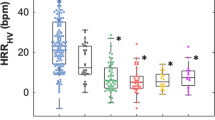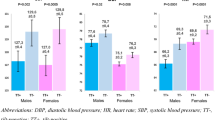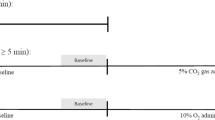Abstract
Based on prior studies, the hypothesis that hyperventilation (HV) may have a pressor effect and play a causal role in hypertension has been suggested. The objective of this study was to correlate HV with blood pressure (BP)-change during a postural challenge. Consecutive subjects referred for evaluation of syncope, dizziness, chronic fatigue syndrome (CFS), fibromyalgia, or non-CFS fatigue were assessed with a 10-min supine 30-min head-up tilt test combined with capnography. We selected for analysis the records of patients aged 17–70 years, not taking vasoactive medications, having sitting systolic BP (SBP)<140 mmHg, sitting diastolic BP (DBP) <90 mmHg, and who completed 30 min of tilt. HV was diagnosed when end-tidal pressure of CO2 <30 mmHg was recorded consecutively for ⩾10 min. Postural hypertension (PHT) was diagnosed when DBP on tilt ⩾90 mmHg was recorded consecutively for ⩾10 min. DBP-change was computed as (median DBP on tilt) −(median DBP supine). PHT and DBP-change were correlated with HV. A total of 320 patient charts were reviewed. PHT was present in 30 cases. The mean DBP-change in patients with PHT was +9.9 mmHg (s.d. 5.8), with three patients manifesting HV. Of the remaining 290 patients, 56 had HV, their mean DBP-change was -0.3 mmHg (s.d. 7.2). The other 234 patients without HV had a mean DBP-change +0.95 mmHg (s.d. 5.7), comparable to the DBP-change in patients with HV. In, conclusion, posturally induced HV was not associated with an increase in BP, nor was PHT associated with HV, except in a small minority of cases.
This is a preview of subscription content, access via your institution
Access options
Subscribe to this journal
Receive 12 digital issues and online access to articles
$119.00 per year
only $9.92 per issue
Buy this article
- Purchase on Springer Link
- Instant access to full article PDF
Prices may be subject to local taxes which are calculated during checkout






Similar content being viewed by others
References
Wieling W, Karemaker JM . Measurement of heart rate and blood pressure to evaluate disturbances in neurocardiovascular control. In: Mathias ChJ (ed) Autonomic Failure. A Textbook of Clinical Disorders of the Autonomic Nervous System, 4 edn. Oxford Univeristy Press: Oxford, 1999, pp 198–210.
Garssen B, Buikhuisen M, van Dyck R . Hyperventilation and panic attacks. Am J Psychiatry 1996; 153: 513–518.
Fortune JB et al. Cerebral blood flow and blood volume in response to O2 and CO2 changes in normal humans.J Trauma 1995; 39: 463–471.
Saisch SG, Deale A, Gardner WN, Wessely S . Hyperventilation and chronic fatigue syndrome. Q J Med 1994; 87: 63–67.
Lehrer PM . Emotionally triggered asthma: a review of research literature and some hypotheses of self-regulation therapies. Appl Psychophysiol Biofeedback 1998; 23: 13–41.
Laffey JG, Kavanagh BP . Hypocapnia. N Engl J Med 2002; 37: 43–53.
Kaplan NM . Anxiety-induced hyperventilation. A common cause of symptoms in patients with hypertension. Arch Intern Med 1997; 157: 945–948.
Malmberg LP, Tamminen K, Sovijarvi AR . Orthostatic increase of respiratory gas exchange in hyperventilation syndrome. Thorax 2000; 55: 295–301.
Simon M et al. Comparison of transcutaneous and endtidal CO2-monitoring for rigid bronchoscopy during high-frequency jet ventilation. Acta Anaesthesiol Scand 2003; 47: 861–867.
Hornsveld H, Garssen B . The low specificity of the Hyperventilation Provocation Test. J Psychosom Res 1996; 41: 435–449.
Spinhoven P, Onstein EJ, Sterk PJ, Le Haen-Versteijnen D . Discordance between symptom and physiological criteria for the hyperventilation syndrome. J Psychosom Res 1993; 37: 281–289.
Steurer J et al. Changes in arterial and transcutaneous oxygen and carbon dioxide tensions during and after voluntary hyperventilation. Respiration 1997; 64: 200–205.
Gardner W . Orthostatic increase of respiratory gas exchange in hyperventilatory syndrome. Thorax 2000; 55: 257.
Naschitz JE et al. The capnography head-up tilt test for evaluation of chronic fatigue syndrome. Semin Arthritis Rheum 2000; 30: 79–86.
Brignole M et al. Task Force Report. Guidelines on management (diagnosis and treatment) of syncope. Eur Heart J 2001; 22: 1256–1306.
Fukuda K et al. The chronic fatigue syndrome: a comprehensive approach to its definition and study. International Study Group. Ann Intern Med 1994; 121: 953–959.
Wolfe F et al. The American College of Rheumatology 1990 criteria for the classification of fibromyalgia: Report of the Multicenter Criteria Committee. Arthritis Rheum 1990; 33: 160–172.
Livneh A et al. Criteria for the diagnosis of familial Mediterranean fever. Arthritis Rheum 1997; 40: 1879–1885.
Naschitz JE et al. The capnography-tilt test for the diagnosis of hyperventilation syncope. Q J Med 1997; 90: 139–145.
Curb JD et al. Training and certification of blood pressure observers. Hypertension 1983; 5: 610–614.
O'Brien E et al. British hypertension protocol: evaluation of automated and semi-automated blood pressure measuring devices with special reference to ambulatory systems. J Hypertens 1990; 8: 607–619.
Shuler CL, Allison N, Holcomb S, Harlan M . Accuracy of automatic blood pressure device in stable inpatients. Arch Intern Med 1998; 158: 714–721.
Naschitz JE et al. In-field validation of automatic blood pressure measuring devices. J Hum Hypertens 2000; 14: 37–42.
Gardner WN, Bass C . Controlled study of respiratory response during prolonged measurement in patients with chronic hyperventilation. Lancet 1986; ii: 826–830.
Rosen SD . Hyperventilation and the chronic fatigue syndrome. Q J Med 1994; 87: 373–374.
Williams H, Freeman LJ, Nixon PG . Hyperventilation and Raynaud's disease. Postgrad Med J 1987; 63: 377–379.
Guzman JA, Kruse JA . Gut mucosal-arterial PCO2 gradient as an indicator of splanchnic perfusion during systemic hypo- and hypercapnia. Crit Care Med 1999; 27: 2760–2765.
Kazmaier S et al. Effects of respiratory alkalosis and acidosis on myocardial blood flow and metabolism in patients with coronary artery disease. Anesthesiology 1998; 89: 831–837.
Todd GP et al. Pressor effect of hyperventilation in healthy subjects. J Hum Hypertens 1995; 9: 119–122.
Fontana F et al. Blood pressure response to hyperventilation test reflects daytime pressor profile. Hypertension 2003; 41: 244–248.
Alexopoulos D et al. Hemodynamic response to hyperventilation test in healthy volunteers. Clin Cardiol 1995; 18: 636–641.
Rosenman RH . Does anxiety or CVR have a causal role in hypertension? Integr Physiol Behav Sci 1991; 26: 296–304.
Young EA, Nesse RM, Weder A, Julius S . Anxiety and cardiovascular reactivity in the Tecumseh population. J Hypertens. 1998; 16 (12, Part 1): 1727–1733.
Naschitz JE et al. Disease-related phenotypes of cardiovascular reactivity as assessed by fractal and recurrence quantitative analysis of the heart rate and pulse transit time. Q J Med 2004; 97: 141–151.
Naschitz JE et al. Assessment of cardiovascular reactivity by fractal and recurrence quantification analysis of heart rate and pulse transit time. J Hum Hypertens 2003; 17: 111–118.
Eguchi K et al. Greater change of orthostatic blood pressure is related to silent cerebral infarct and cardiac overload in hypertensive subjects. Hypertens Res 2004; 27: 235–241.
Thomas RJ et al. Positional change in blood pressure and 8-year risk of hypertension: the CARDIA Study. Mayo Clin Proc 2003; 78: 951–958.
Jokinitty J et al. Can blood pressure responses to tests unmask future blood pressure trends and the need for antihypertensive medication? Ten years of follow-up. Clin Physiol Funct Imaging 2002; 22: 125–133.
Saish SGN, Deale A, Gardner WN, Wessely S . Hyperventilation and chronic fatigue syndrome. Q J Med 1994; 87: 63–67.
Nixon PGF . An appraisal of Thomas Lewi's effort syndrome. Q J Med 1995; 88: 741–747.
Wecksser M et al. Functional imaging of the visual cortex with bold-contrast MRI: hyperventilation decreases signal response. Magn Reson Med 1999; 41: 213–216.
Huttunen J et al. Effects of voluntary hyperventilation on cortical sensory responses: electroencephalographic and magnetoencephalographic studies. Exp Brain Res 1999; 125: 248–254.
Graham EM, Apostolou M, Mishra OP, Delivoria-Papadopoulos M . Modification of the N-methyl-D-aspartate (NMDA) receptor in the brain of newborn piglets following hyperventilation induced ischemia. Neurosci Lett 1996; 218: 29–32.
Author information
Authors and Affiliations
Corresponding author
Rights and permissions
About this article
Cite this article
Naschitz, J., Mussafia-Priselac, R., Peck, E. et al. Hyperventilation and amplified blood pressure response: is there a link?. J Hum Hypertens 19, 381–387 (2005). https://doi.org/10.1038/sj.jhh.1001830
Received:
Revised:
Accepted:
Published:
Issue Date:
DOI: https://doi.org/10.1038/sj.jhh.1001830
Keywords
This article is cited by
-
Anxiety in the “Age of Hypertension”
Current Hypertension Reports (2014)
-
Nonspecific dizziness: frequency of supine hypertension associated with hypotensive reactions on head-up tilt
Journal of Human Hypertension (2006)



